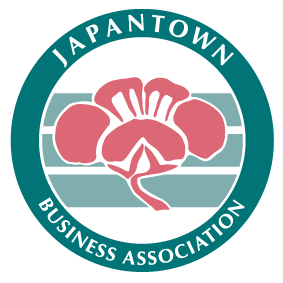Major projects between the former Redevelopment Agency of San Jose, City of San Jose, and Japantown
Building facade improvements for signed contracts with the former Redevelopment Agency.
A Neighborhood Business District Airport Committee was formed for pursuing marketing possibilities at the San Jose Mineta International Airport. JBA effort.
Prop 40 and SB 307 funding continued as planned with the Japantown Community Congress of San Jose being named the official partner organization to the city in these efforts, by resolution of the San Jose City Council, October 14, 2003.
Directional signage went forward with the possibility of additional signs to go on the west side of Coleman and Taylor (new development) to direct traffic to Japantown.
The Landmark work at 5th & Jackson became the Nikkei Lantern, the Issei Voices Wall and timeline. Also added was the Issei Memorial (granite rock from Inujima Island - Okayama Sister City project with donation from the Jimi Yamaichi family.
Historic markers for Japantown sites - academic identification and compilation/writing work completed and turned into CA State Library as added to the San Francisco and Los Angeles reports.
Historic District Survey - a first assessment and historic context statement for the preservation of Japantown (to aid development and restrain urban renewal destruction) with money acquired from a grant written by SJ City Historic Preservation Officer, Courtney Damkroger for Japantown to provide accurate information for benefits that may be gained from such studies. This was followed by the second phase, documenting parcels.
The CCPLEP 3-Japantown landmark can be seen in front of the Issei Memorial Building. The three Japantowns each have a similar monument linking the histories of the districts. One panel is specifically designed to accentuate a specific landscape feature of the Japantown in which the monument resides.
The Corporation Yard Archaeological Survey, 2009
Heinlenville was one of six San José Chinatowns, located in present-day Japantown. Archaeologists from the Anthropological Studies Center, Sonoma State University and local San Jose historians worked with the former Redevelopment Agency and City of San Jose to unearth selected areas of Heinlenville and early Japantown. The test excavation took place from the 11th to 17th March 2008, and data recovery excavation was conducted from the 14th to 23rd of April 2009.
Intensive Level Survey and Refined Historic Context, 2005
The City and the Japantown Community Congress conducted an intensive level survey and refined the historic context as Phase II of the three-part Japantown survey and preservation project. Phase II provided baseline information about the location and significance of historic resources and was the critical step in understanding Japantown as a possible Traditional Cultural Property.
The City will contract with a preservation planning and survey professional meeting the Secretary of the Interior’s Standards to conduct an intensive level survey of between 75 and 175 buildings, complete Department of Parks and Recreation 523 A and B forms with photographs, and refine the historic context developed in Phase I. The intensive level survey and refinement of the historic context will provide answers to the community and City regarding Japantown’s potential to qualify as a Traditional Cultural Property as well as for other designation options such as a National Register or City Landmark Historic district.
Regular updates on the project will be posted on the Department of Planning, Building and Code Enforcement, Historic Preservation website, and regular reports will be made to the Historic Landmarks Commission. The project will provide the individual significance determinations for buildings in the community that are important for owners in the development process. Funding for Phase II of the project came from a California Civil Liberties Public Education Program Grant, a National Trust for Historic Preservation Johanna Favrot Fund for Historic Preservation Grant, and an Office of Historic Preservation Certified Local Government Grant.
The Historic District Survey, 2004
The Japantown Historic Context and Reconnaissance Level Survey was completed in September 2004 and formally accepted by the Historic Landmarks Commission in November 2004 and the San Jose City Council in January 2005. The report was conducted by historic resource consultants Carey & Co. Inc. under the direction of the San Jose Planning Department and a survey committee composed of members of the Japantown Community Congress, Japantown Business Association, Historic Landmarks Commission, and the San Jose Redevelopment Agency. Funding for the project came from a federal grant, local grant and city funding.
The Japantown Survey and Preservation Project, 2004
The report consists of the development of a Japantown historic context and a reconnaissance level survey of 67 buildings within and around the commercial core. Historic contexts are the patterns and trends in history by which a specific occurrence, property, or site is understood and its meaning (and significance) within history or prehistory is made clear. In the case of the Japantown project, the historic context is a record of the area from the perspective of the built environment and how that environment helps to interpret the history of Japanese Americans in San Jose and the United States.
The Japantown Historic Context and Reconnaissance Level Survey was completed in September 2004 and formally accepted by the Historic Landmarks Commission in November 2004 and the San Jose City Council in January 2005. The report was conducted by historic resource consultants Carey & Co. Inc. under the direction of the San Jose Planning Department and a survey committee composed of members of the Japantown Community Congress, Japantown Business Association, Historic Landmarks Commission, and the San Jose Redevelopment Agency. Funding for the project came from a federal grant, local grant and city funding.
Copies of the report have been distributed to the California Room at the Martin Luther King Jr. Library, History San Jose and the Japanese American Resource Center/Museum.
